2. 中国地质科学院国家地质实验测试中心, 北京 100037;
3. 中国地质科学院矿产资源研究所, 北京 100037
2. National Research Center for Geoanalysis, Chinese Academy of Geological Sciences, Beijing 100037, China;
3. Institute of Mineral Resources, Chinese Academy of Geological Sciences, Beijing 100037, China
在众多不同类型结晶岩中,石榴子石是常见矿物之一,包含三种成因类型的石榴子石:岩浆型、变质型或转熔型。变质型石榴子石是指不同类型岩石在变质作用过程中形成的。在变沉积岩和变中基性岩石的黑云母和角闪石脱水部分熔融反应形成转熔型石榴子石(Le Breton and Thompson, 1988; Rapp et al., 1991; Wolf and Wyllie, 1991, 1993, 1994; Wyllie and Wolf, 1993; Rapp and Watson, 1995; Spear and Kohn, 1996; Patiño Douce and Harris, 1998)。在演化程度较高的花岗岩和混合岩的淡色体中,石榴子石是常见的副矿物之一,其成因包括:1)岩浆型,即石榴子石是从硅酸质岩浆结晶形成(Green, 1976, 1977;Cawthorn and Brown, 1976; Abbott, 1981; Allan and Clarke, 1981; Miller and Stoddard, 1981; Dahlquist et al., 2007; 高利娥等, 2012;Yang et al., 2013; Liu et al., 2014, 2016; Gao et al., 2016; 郭春丽等, 2017);和2)捕获型,包括捕获围岩的变质成因的石榴子石(Warren, 1970; Allan and Clarke, 1981; Clarke, 2007)或捕获岩浆源区转熔型石榴子石(Zeng et al., 2005, 2012; Stevens et al., 2007; 曾令森等, 2008; Villaros et al., 2009; Zhao et al., 2012, 2017; 焦淑娟等, 2013; Jiao et al., 2015; Rong et al., 2017, 2018)。在同一花岗岩体中,这些不同成因的石榴子石在形态、包裹体组合、主量和微量元素地球化学特征上都表现出较明显的差异性(Hall and Tyler, 1965; Warren, 1970; Cawthorn and Brown, 1976; Green, 1976, 1977; Abbott, 1981; Allan and Clarke, 1981; Miller and Stoddard, 1981; Du Bray, 1988; Stevens et al., 2007; Villaros et al., 2009;高利娥等, 2012, 2017b;夏琼霞等, 2013;郭春丽等,2017)。虽然对岩浆岩中的石榴子石开展了大量的矿物学和矿物化学的研究,但对其成因的认识存在较大的分歧。大量研究揭示了花岗岩中的多数石榴子石具有高MnO的含量,锰铝榴石的组分较高(Abbott, 1981; Miller and Stoddard, 1981;高利娥等, 2012;郭春丽等,2017),最近的大量研究都发现含石榴子石的花岗岩的MnO含量并不高,常常非常低(~0.1%),与不含石榴子石花岗岩的浓度相当(Miller and Stoddard, 1981;高利娥等, 2012;郭春丽等,2017),不支持花岗岩具有较高的MnO是控制花岗岩结晶石榴子石的观点(Hall and Tyler, 1965)。后续的研究发现在岩浆演化后期,贫Mn矿物(如石英和长石)的分离结晶作用,导致岩浆的Mn升高,促使结晶石榴子石(Abbott, 1981; Miller and Stoddard, 1981;高利娥等, 2012);但在同期共生花岗岩系列中,岩浆型石榴子石的元素地球化学特征如何随岩浆演化而演化是有待探讨的课题。
喜马拉雅造山带发育形成时代各异的花岗质岩浆岩,其形成时代从早元古代至新生代(DiPietro and Isachsen, 2001; Miller et al., 2001; Lee et al., 2004; Gehrels et al., 2006; Richards et al., 2006; Cawood et al., 2007; Groppo et al., 2007; Murphy, 2007; Quigley et al., 2008; 张泽明等,2008; 王誉桦等, 2014; 高利娥等, 2015; Liu et al., 2016; Wang et al., 2015, 2017; Huang et al., 2017; Hu et al., 2018; Gao et al., 2019及其中的参考文献),其中,年龄大于50Ma都以花岗质片麻岩的形式产出, 这其中的许多岩体也含石榴子石。多数喜马拉雅新生代花岗岩都伴生含石榴子石的淡色花岗岩(吴福元等, 2015;曾令森和高利娥, 2017),为了解花岗质岩浆岩中的石榴子石的矿物化学行为提供了良好的机会。为探讨高Sr/Y比二云母花岗岩向淡色花岗岩演化过程中石榴子石的矿物化学行为,本文选取发育于藏南雅拉香波穹隆、具有代表性的含石榴子石二云母花岗岩(T0394-16)和伴生的淡色花岗岩(T0394-20)中的石榴子石作为研究对象,对其开展了微量元素地球化学测试,籍此来探讨在不同性质花岗岩中石榴子石的矿物化学行为及其影响因素。
1 地质背景及其样品描述所研究的样品均采自西藏南部特提斯喜马拉雅带的雅拉香波穹窿。特提斯喜马拉雅带位于雅鲁藏布江缝合带(YTS)与藏南拆离系(STDS)之间(图 1a),由一系列断续分布的穹窿体组成(Burg et al., 1984;Hodges,2000;Zhang et al., 2004;张进江等,2007;高利娥等, 2009, 2012;谢克家等,2010; King et al., 2011; Zeng et al., 2011a, 2015)。自核部向边部,雅拉香波穹窿依次由高级变质岩系、中级变质岩系和沉积岩系3个岩石单元及侵入其中的花岗岩体组成,各岩石单元之间为韧性或脆韧性拆离断层环绕穹隆分布(图 1b)(张进江等,2007; Zhang et al., 2012; Zeng et al., 2011a)。高级变质岩系分布于穹隆核部,由含石榴子石花岗质片麻岩、含石榴子石、夕线石和十字石变泥质岩、石榴角闪岩、石榴辉石岩及侵入其中的新生代花岗岩组成。中级变质岩系由石榴石片岩组成。沉积岩系为特提斯海相碎屑沉积岩。岩浆岩主要由分布于穹隆核部的二云母花岗岩体及岩脉或席状的淡色花岗岩组成。在穹隆北部,淡色花岗岩以厚度不一的岩脉方式侵入到石榴片岩或片麻岩中,并在顶部形成连续的岩席。锆石U/Pb定年结果表明:自新生代以来,花岗片麻岩和石榴角闪岩分别记录了发生在47.6±1.8Ma和45.0±1.0Ma期间与地壳增厚作用相关的变质作用(Gao et al., 2012);高Sr/Y比二云母花岗岩形成于43~44Ma (Aikman et al., 2008; 戚学祥等,2008;Zeng et al., 2011a, 2015;Hou et al., 2012),与石榴角闪岩的部分熔融作用时间(43.5±1.3Ma)类似; 岩脉状淡色花岗岩形成于~35.3Ma(曾令森等, 2009); 部分较大规模的淡色花岗岩体和高Sr/Y比二云母花岗岩近乎同时形成,为18~20Ma(Zeng et al., 2011b; 曾令森等,2012),与多数喜马拉雅淡色花岗岩的形成时间类似(Le Fort et al., 1987; Searle et al., 1997; Harrison et al., 1999; Zhang et al., 2004; King et al., 2011; 于俊杰等, 2011; Gao and Zeng, 2014)。

|
图 1 喜马拉雅造山带地质简图(a, 据Zeng et al., 2011a)和雅拉香波穹窿地质简图(b) YTS-雅鲁藏布缝合带;STDS-藏南拆离系;MCT-主中央逆冲推覆带;MBT-主边界逆冲推覆带;LH-小喜马拉雅岩系.锆石U-Pb年龄数据包括Aikman et al. (2008), Zeng et al.(2011a, 2015)和Gao et al. (2012) Fig. 1 Simplified geologic map of the Himalayan orogenic belt, southern Tibet (a, after Zeng et al., 2011a) and simplified geologic map of the Yardoi area showing the Yardoi Gneiss Dome (YGD), the Dala and the Quedang plutons (b) YTS-Yarlung-Tsangpo Suture; STDS-Southern Tibet Detachment System; MCT-Main Central Thrust; MBT-Main Boundary Thrust; LH-Lower Himalayan Crystalline Sequence. Zircon U/Pb age data from Aikman et al. (2008), Zeng et al.(2011a, 2015) and Gao et al. (2012) |
样品T0394-16是典型的二云母花岗岩,由石英、斜长石、黑云母、白云母、和少量钾长石组成,副矿物为磷灰石、锆石和石榴子石(图 2a, b),其中部分斜长石较自形具有明显的韵律环带。与始新世二云母花岗中的磷灰石不同,这些二云母花岗岩的磷灰石不含继承性组分(曾令森等,2012)。样品T0394-20为淡色花岗岩,由石英、斜长石、钾长石和少量的石榴子石组成,黑云母含量明显较少(图 2c, d)。从石榴子石的形态来看,这些花岗岩中的石榴子石都为自形-半自形,几乎不含包裹体(图 2)。
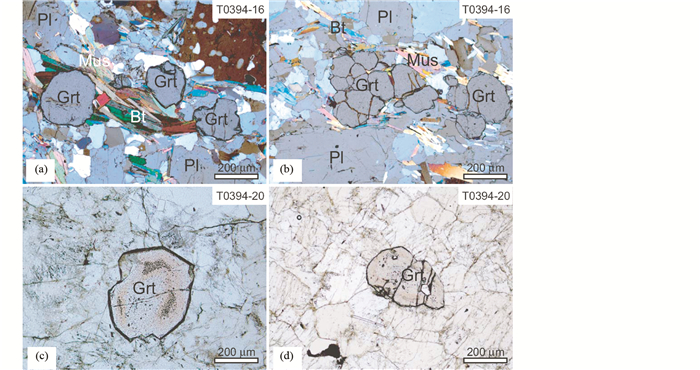
|
图 2 雅拉香波二云母花岗岩(a、b)和淡色花岗岩(c、d)显微照片 Qtz-石英;Grt-石榴子石;Pl-斜长石;Mus-白云母;Bt-黑云母;Ap-磷灰石 Fig. 2 Microphotographs showing the texture and mineral assemblage of two-mica granite (a, b) and leucogranite (c, d) from the Yardoi gneiss dome Qtz-quartz; Grt-garnet; Pl-plagioclase; Mus-muscovite; Bt-biotite; Ap-apatite |
为限定花岗岩中石榴子石的成因,选择了4件石榴角闪岩样品,测试了这些石榴角闪岩中石榴子石和角闪石的矿物化学组成。在石榴角闪岩样品中,除了T0394-AM显示明显的混合岩化外,其它3件样品都由角闪石、斜长石、石榴子石和绿帘石组成,副矿物包括榍石、磷灰石、锆石和金红石。该样品为混合岩化石榴角闪岩,经历了部分熔融作用,主要由角闪石、斜长石、石榴子石、黑云母、绿帘石和少量钾长石和石英组成,副矿物主要为榍石、磷灰石、锆石和金红石;部分区域为条带状淡色体,由石英、斜长石和钾长石组成;外围为中色体,由石榴子石、角闪石、斜长石、绿帘石和榍石组成,部分熔融作用的时间为43.5±1.3Ma(Zeng et al., 2011a)。其它3件石榴角闪岩显示相似的结构和矿物组成,主要由角闪石、斜长石、石榴子石、石英、黑云母、白云母以及少量的榍石、金红石、磷灰石和锆石组成,部分石榴子石发生了明显的退变质作用,边部围绕由黑云母、斜长石组成的后成合晶,呈“白眼圈”结构,同时多数石榴子石内部包含石英、云母和金红石等包裹体,部分构成包裹体痕迹,指示这些石榴子石为同构造碎斑晶,经历了强烈的剪切变形作用,但不显示部分熔融的显微结构。其中T0388的变质年龄为45.0±1.0Ma(Gao et al., 2012)。
2 测试方法 2.1 SHRIMP和LA-ICP-MS锆石U/Pb定年为了确定花岗岩的形成年代, 从二云母花岗岩样品T0394-16和淡色花岗岩样品T0394-20中挑选锆石, 经过手工挑选、制靶和抛光, 然后通过阴极发光(CL)和扫描电镜背散射(BSE)成像观察, 揭示锆石的内部结构。CL和BSE成像分别在中国地质科学院地质研究所北京离子探针中心和自然资源部深部动力学重点实验室完成。在CL和BSE图像的指导下, 甄别锆石不同生长域的特征,选取U-Pb测试点。SHRIMP锆石U-Pb同位素定年测试在北京离子探针中心完成,所用仪器为高分辨率高灵敏度离子探针SHRIMP II。测试前用锆石标样M257校正U的浓度,分析时标样为TEM锆石(206Pb/238U年龄=417Ma),每测定3个未知点,插入一次标样测定,以便及时校正,保障测试精度。测试结果见表 1。
|
|
表 1 西藏南部雅拉香波穹窿二云母花岗岩(样品T0394-16)SHRIMP锆石U-Pb定年数据 Table 1 SHRIMP U-Pb analytical results for zircons from two-mica granite (Sample T0394-16) in Yardoi Gneiss Dome, southern Tibet |
LA-ICP-MS锆石U-Pb同位素定年测试在中国地质科学院矿产资源研究所成矿作用与资源评价重点实验室完成。所用仪器为Neptune型激光多接收等离子体质谱(LA-MC-ICPMS), 采用美国New Wave UP213nm激光剥蚀系统进样, 激光剥蚀斑束直径为25μm, 频率为10Hz, 能量密度约为2.5J/cm2, 以He为载气。U和Th含量的外标校正采用锆石标样M127 (U=923×10-6; Th=439×10-6; Th/U=0.475)。在测试中, 每测定10个样品点前后重复测量两次锆石标样GJ-1和一次锆石标样Plesovice。分析数据的离线处理采用软件ICPMSDataCal完成(Liu et al., 2010), 锆石年龄谐和图用Isoplot 3.0程序获得。测试结果见表 2。
|
|
表 2 西藏南部雅拉香波穹窿淡色花岗岩(样品T0394-20)LA-ICP-MS锆石U-Pb定年数据 Table 2 LA-ICP-MS U-Pb analytical results for zircons from leucogranite (Sample T0394-20) in Yardoi Gneiss Dome, southern Tibet |
雅拉香波中新世花岗岩的元素地球化学组成在中国地质科学院国家地质实验测试研究中心进行。主量元素组成通过XRF(X荧光光谱仪3080E)方法测试,分析精度为5%。通过等离子质谱仪(ICP-MS-Excell)分析微量元素和稀土元素(REE)含量,含量大于10×10-6的元素的测试精度为5%,小于10×10-6的元素精度为10%。含量较低的元素,测试误差大于10%。测试结果见表 3。
|
|
表 3 西藏南部雅拉香波中新世二云母花岗岩和淡色花岗岩地球化学组成(主量元素:wt%; 微量元素: ×10-6) Table 3 Whole-rock geochemical compositions of Mid-Eocene two-mica granites and leucogranite from the Yardoi Gneiss Dome, southern Tibet (major oxides: wt%; trace element: ×10-6) |
全岩Rb-Sr和Sm-Nd同位素组成在中国地质科学院地质研究所同位素实验室完成。采用同位素稀释法,Sr同位素组成及Rb、Sr、Sm和Nd的浓度利用Finnigan MAT-262质谱仪测试。Nd同位素分析利用Nu Plasam HR MC-ICP-MS多接受等离子质谱仪(Nu Instruments)。Nd和Sr分析结果质量分馏校正分别按146Nd/142Nd=0.7219和86Sr/88Sr=0.1194进行。Sr和Nd同位素测试标准分别为NBS987和JMCNd,样品测试期间的测试值分别为0.710247±12 (2σ)和0.511127±12 (2σ),测试精度分别为±0.000010 (n=18)和±0.000011 (n=18)。根据锆石U-Pb定年的结果,所分析样品的Sr和Nd同位素的初始值按t=20Ma计算,分析结果见表 3。
2.3 矿物微量元素测试石榴子石和角闪石微区原位微量元素分析在中国地质科学院国家地质测试分析研究中心进行。所用仪器为Finnigan ELEMENT 2 ICP-MS。激光剥蚀系统为新浪UP-213nm激光器。分析采用的激光剥蚀孔径为44μm, 激光脉冲为10Hz, 能量为90mJ。详细的分析方法和流程同胡明月等(2008)。数据处理过程中选择Ca作为内标元素, 国际标准玻璃NIST610用于外标校正。绝大部分微量元素分析的准确度优于10%, Be、P、Ni、Zn、Ga和Yb的准确度优于20%。石榴子石和角闪石单矿物LA-ICP-MS分析结果见表 4和表 5。
|
|
表 4 雅拉香波中新世花岗岩和石榴角闪岩中石榴子石的元素地球化学组成(主量元素:wt%;微量元素: ×10-6) Table 4 Chemical compositions in garnet grains from the Mid-Miocene granites and garnet amphibolites of the Yardoi Gneiss Dome (major oxides: wt%; trace element: ×10-6) |
|
|
表 5 雅拉香波石榴角闪岩中角闪石的元素地球化学组成(主量元素:wt%;微量元素: ×10-6) Table 5 Chemical compositions in hornblende grains from garnet amphibolite of the Yardoi Gneiss Dome (major oxides: wt%; trace element: ×10-6) |
样品T0394-16为富钠过铝质花岗斑岩,矿物组成为石英、斜长石、白云母、黑云母和钾长石。大部分锆石为自形长柱状(图 3),个别为自形短柱状。100~300μm长,多数锆石长宽比为2.5,个别可达5.0。多数锆石具有继承性的核部,具明显的韵律环带(图 3)。测试结果表明:锆石核部U和Th的浓度变化都较大,分别为137×10-6~854×10-6和35×10-6~313×10-6;除1点外,Th/U比值较高,大于0.1。206Pb/238U年龄从216.6Ma到1131Ma。这些核部继承性锆石与其它北喜马拉雅片麻岩穹窿的淡色花岗岩类似(Aoya et al., 2005;Aikman et al., 2008; 戚学祥等,2008),表明这些花岗岩来源于古老大陆地壳物质的部分熔融作用。边部锆石具有明显的韵律环带,U和Th含量分别在371×10-6~671×10-6和11×10-6~28×10-6之间,Th/U值在0.03~0.08之间(表 1)。它们的Th/U比值虽然较小,这种特征是从地壳重熔产生的熔体中结晶出来的共性(Lee and Whitehouse, 2007; 曾令森等,2009)。根据206Pb/238U年龄,可分为三组。除1点年龄为~41.1Ma和2点年龄小于18.0Ma外,其他9点年龄较聚中,在19.6±0.4~21.6±0.5Ma之间。总体来看,这些锆石的年龄差不大,SHRIMP U/Pb年龄则集中分布于19.6±0.4~21.6±0.5Ma之间(表 1、图 3),在谐和图上,所有样品点相对集中分布于一致线的20.3Ma附近区域,9测试点计算得到平均年龄值为20.3±0.5Ma(MSWD=2.1)(图 3),这组年龄数据点在谐和图上相对集中分布,是锆石的结晶年龄,反映了岩浆的结晶时代。其中小于18.0Ma的锆石年龄值与其他点相比明显偏小,反应了在花岗岩结晶之后,可能经历了另一次变质事件。年龄为~41.1Ma的锆石可能是捕获的早期二云母花岗岩的锆石。
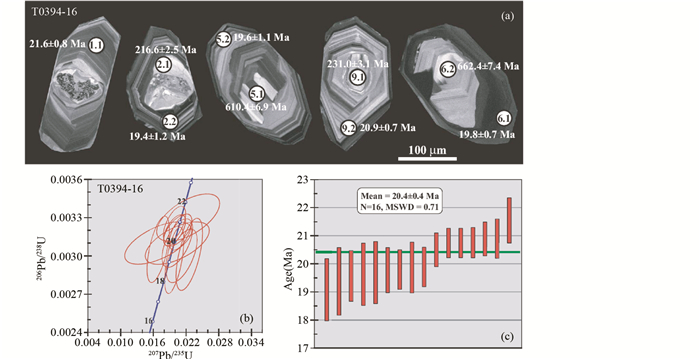
|
图 3 西藏南部雅拉香波穹窿二云母花岗岩(T0394-16)锆石U-Pb地质年代学结果图解 (a)阴极发光(CL)图像,显示锆石内部结构及U-Pb测试位置;(b)U-Pb谐和图;(c)年龄分布图 Fig. 3 Diagrams showing the zircon U-Pb analytical results for the two-mica granite (T0394-16) from the Yardoi Gneiss Dome, southern Tibet (a) CL images showing the internal textures and respective spots of zircon grains for U-Pb isotope analyses; (b) U-Pb concordia diagram; (c) age distribution diagram |
样品T0394-20为含石榴子石淡色花岗岩,矿物组成为石英、斜长石、白云母、钾长石和少量石榴子石。其多数锆石为自形长柱状(图 4a),个别为自形短柱状。长100~300μm,多数长宽比为1.5~2.5(图 4a)。多数锆石具有核-幔-边结构,核部和边部普遍具有韵律环带(图 4a),幔部为均匀特征。在21个边部锆石测试点中,除1点测试结果为45.9±1.5Ma外,其他20点的206Pb/238U年龄较集中,在19.5±0.6Ma和21.8±1.8Ma之间,相对集中分布于一致线的20.1Ma附近区域(图 4b),平均年龄值为20.1±0.3Ma(N=20, MSWD=0.74)(图 4c)。虽然这些点的Th(9.5×10-6~891.1×10-6)和U(514.7×10-6~2740×10-6)及Th/U(0.004~0.954)比值变化都较大,但清晰的韵律环带表明边部锆石是从硅酸质溶体中结晶的,代表该淡色花岗岩的结晶年龄。
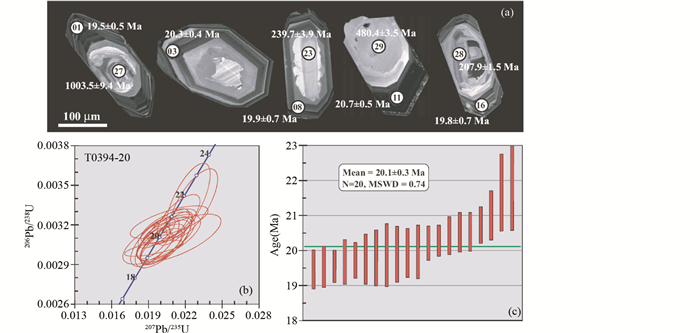
|
图 4 西藏南部雅拉香波穹窿淡色花岗岩(T0394-20)锆石U-Pb地质年代学结果图解 (a)阴极发光(CL)图像,显示锆石内部结构及U-Pb测试位置;(b)U-Pb谐和图;(c)年龄分布图 Fig. 4 Diagrams showing the zircon U-Pb analytical results for the leucogranites (T0394-20) from the Yardoi Gneiss Dome, southern Tibet (a) CL images showing the internal textures and respective spots of zircon grains for U-Pb isotope analyses; (b) U-Pb concordia diagram; (c) age distribution diagram |
幔部较宽的锆石给出28.6±0.9Ma的年龄,与佩古错、夏如和苦堆的淡色花岗岩的年龄相似(Zhang et al., 2004; King et al., 2011; Gao et al., 2013, 2016; Gao and Zeng, 2014),可能预示着雅拉香波穹隆也经历了该期地壳深熔作用。其余核部锆石206Pb/238U年龄从207.9Ma到1003.5Ma,可能是捕获岩浆源区的继承性锆石。边部年龄为45.9±1.5Ma的锆石,与雅拉香波地区广泛分布的43~45Ma云母花岗岩(Zeng et al., 2011a, 2015; Hou et al., 2012)的锆石相似,可能是捕获早期二云母花岗岩的锆石。
3.2 花岗岩的地球化学特征在主量元素组成上,中新世二云母花岗岩具有以下特征(表 3):(1)较高的SiO2(72.0%~75.3%)、Al2O3(15.1%~16.3%)、Na2O(4.4%~5.5%)含量和A/CNK(1.17~1.30)、Na2O/K2O(>2.44)比值,显示过铝质富钠的特征;(2)具有较高的Sr(370×10-6~550×10-6),较低的Rb、Ba、Y(< 5.8×10-6)和Yb含量(< 0.6×10-6),Sr/Y(86.5~216.6)和La/Yb(18.0~37.8)比值较高(图 5);(3)Nb/Ta和Zr/Hf比值都低于球粒陨石(Nb/Ta=19.9, Zr/Hf=35~40),分别为7.3~13.3和22.4~32.7;(4)强烈富集LREE, 亏损HREE,(La/Yb)N=12.7~26.6,但从Er到Lu具有变平的趋势((Ho/Yb)N=1.05~1.19)(图 6);(5)微弱的负Eu异常到微弱的正Eu异常(Eu/Eu*=0.61~1.25)。上述特征与始新世高Sr/Y比二云母花岗岩类似(高利娥等, 2010; 谢克家等, 2010;Zeng et al., 2011a, 2015)。
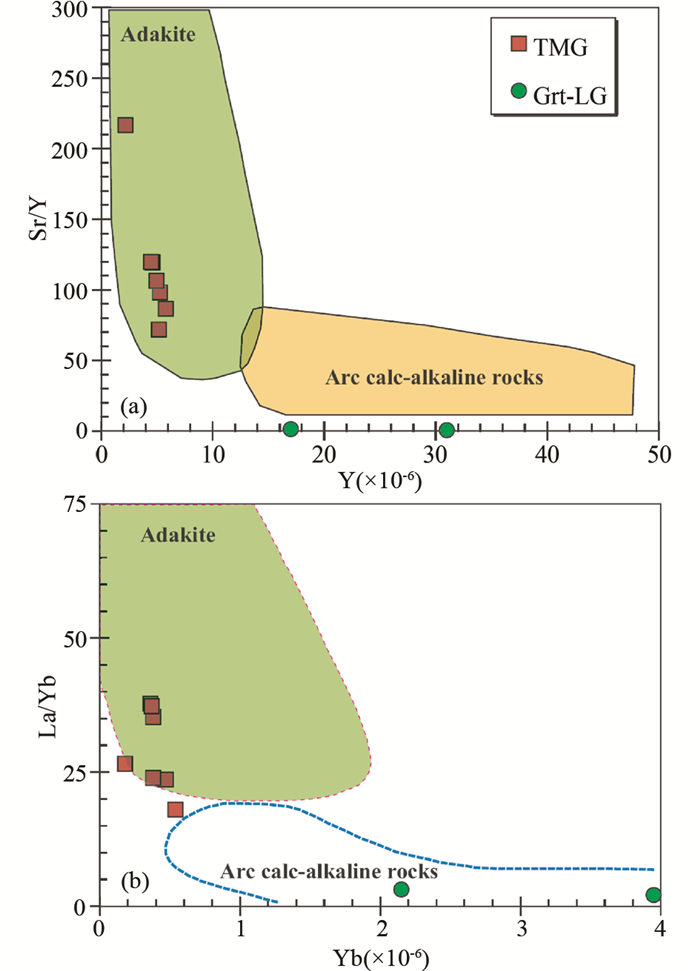
|
图 5 藏南雅拉香波二云母花岗岩和淡色花岗岩Sr/Y-Y(a)和La/Yb-Yb(b)图解 Fig. 5 Co-variation diagrams of Sr/Y vs. Y (a) and La/Yb vs. Yb (b) for the two-mica granite (TMG) and the leucogranite (Grt-LG) from the Yardoi Gneiss Dome, southern Tibet |
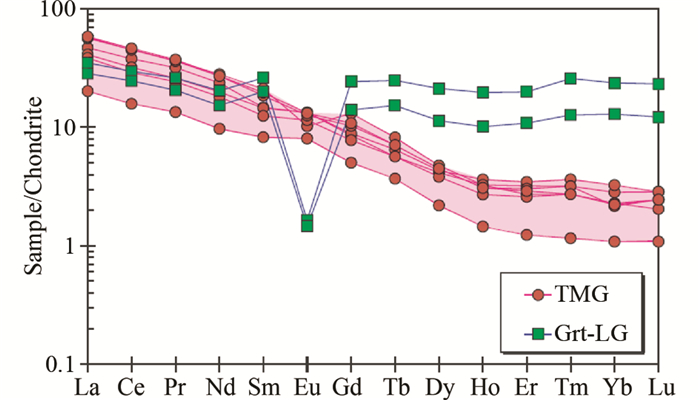
|
图 6 藏南雅拉香波二云母花岗岩和淡色花岗岩全岩稀土元素配分特征 Fig. 6 REE Distribution patterns for two-mica granite (TMG) and leucogranite (Grt-LG) from the Yardoi Gneiss Dome, southern Tibet |
与二云母花岗岩相比,淡色花岗岩表现以下特征(表 3):(1)SiO2含量较低,在68.0%~71.4%之间,但Al2O3含量较高,大于15.5%;(2)TiO2、FeO、MgO、MnO和CaO含量较低,MnO含量小于0.1%,但K2O(5.7%~6.4%)较高,样品中A/CNK比值为1.02~1.04,显示弱过铝质的特征;(3)具有较低的Sr(< 20.7×10-6),较高的Rb (>337×10-6)、Y(>17.0×10-6)和Yb(>2.15×10-6), 较低的Sr/Y(< 1.2)和La/Yb(< 3.1)比值(图 5);(4)Nb/Ta(< 5.5)和Zr/Hf(< 18.3)比值都较低;(5)具有海鸥状REE分布特征,LREE与二云母花岗岩相当,但明显富集HREE,(La/Yb)N=1.47~2.21,但从Er到Lu具有变平的趋势((Gd/Yb)N=1.02~1.08);(6)明显的负Eu异常(Eu/Eu* < 0.10)(图 6)。
二云母花岗岩岩具有较低Sr同位素(87Sr/86Sr(t)=0.7091~0.7098)和较高的Nd同位素(εNd(t)=-7.7~-8.5)组成。淡色花岗岩的Sr同位素(87Sr/86Sr(t)=0.7100~0.7103)稍微较高,但Nd同位素组成稍微较低,为εNd(t)=-9.1~-9.2 (表 3)。
3.3 石榴子石地球化学特征为了限定石榴子石的矿物化学成分变化特征,排除花岗岩中的石榴子石是捕获源区石榴子石的可能性,分别从二云母花岗岩T0394-16、淡色花岗岩T0394-20和4件石榴角闪岩(T0388、T0394-10、T394-1和T0394-AM)样品中选择了粒度较大、具有代表性的石榴子石,测试了它们的元素地球化学组成。在测试过程中,通过对比显微照片和BSE图像,尽量避开含包裹体区域,进行原位LA-ICP-MS测试。但个别点还是可能包含微米级包裹体,因此,首先对数据进行了细致的分析,鉴别出明显影响石榴子石的REE、Zr、Hf、Y等元素的包裹体,再确定石榴子石的有效微量元素地球化学特征。测试结果表明(表 4),在同1件样品中,不同石榴子石表现出相似的地球化学特征。
3.3.1 花岗岩中岩浆型石榴子石二云母花岗岩和淡色花岗岩中石榴子石的端元组成分别为Py8.3-10.3Alm59.3-61.4Gross6.1-8.2Spess13.6-25.5和Py2.4-2.9Alm65.8-72.1Gross0-4.6Spess21.9-27.4 (表 4)。与二云母花岗岩相比,淡色花岗岩中的石榴子石的锰铝榴石和钙铝榴石的组分较低,但铁铝榴石和锰铝榴石的组分较高(图 7)。在雅拉香波中新世花岗岩中,从核部到边部,石榴子石的铁铝榴石组分(Alm)升高,锰铝榴石组分(Spess)降低,两者之间呈镜像关系,镁铝榴石组分(Py)略升高,显示了典型的生长环带的特征(图 8、图 9)。
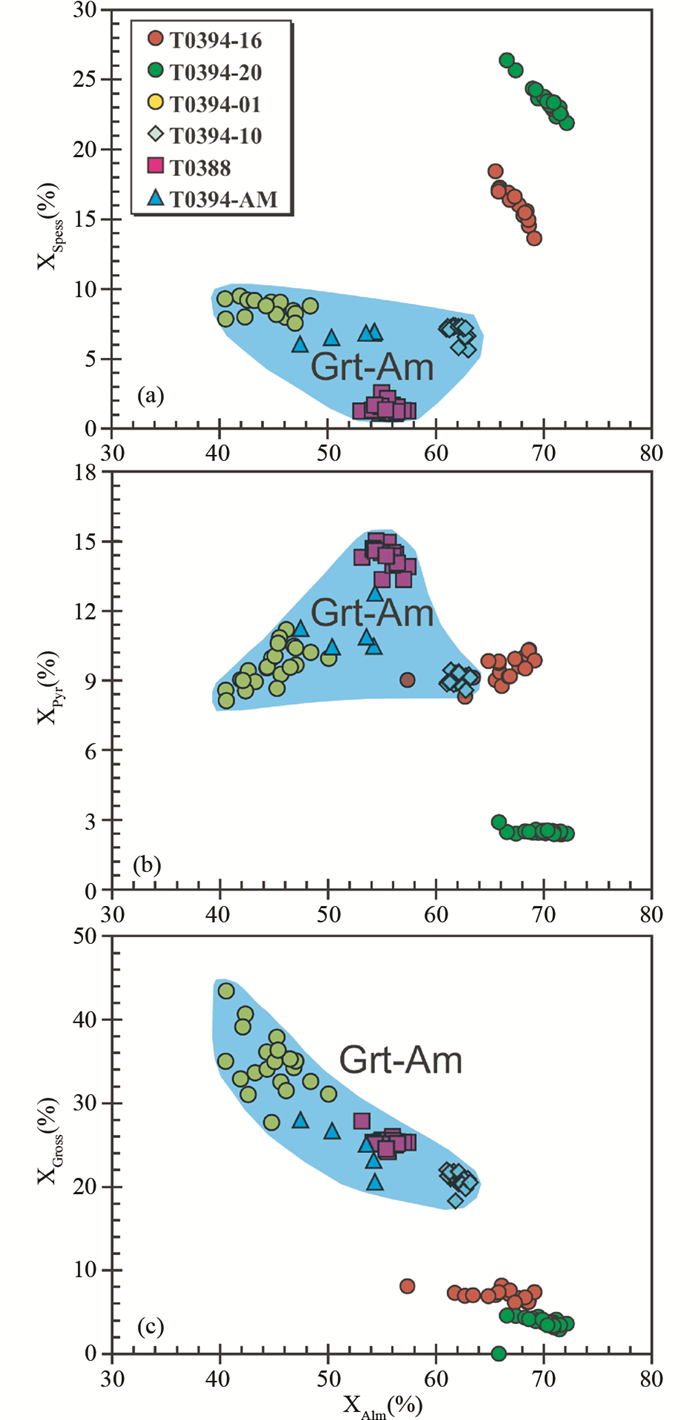
|
图 7 藏南雅拉香波穹窿花岗岩和石榴角闪岩中石榴子石端元组分关系图 Fig. 7 End-member co-variation diagrams of XSpess, XPyr and XGross vs. XAlm for the garnet grains from granites as well as from garnet amphibolite in the Yardoi Gneiss Dome, southern Tibet |
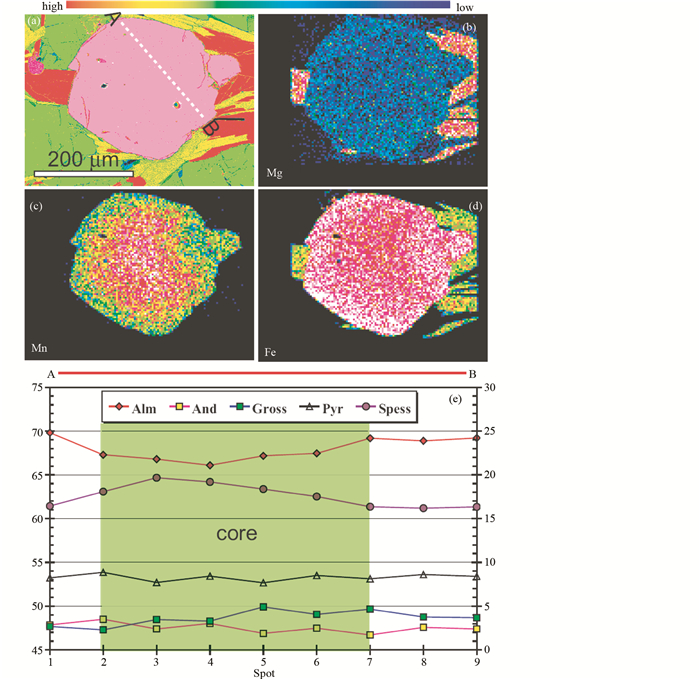
|
图 8 雅拉香波穹窿中新世二云母花岗岩中石榴子石矿物化学变化特征 (a)显微照片;Mg (b)、Mn (c)和Fe (d)元素X光成分图;(e)端元组分剖面变化图 Fig. 8 Mineral chemistry of magmatic garnet in the two-mica granite from the Yardoi Gneiss Dome (a) micrograph; X-ray map of Mg (b), Mn (c) and Fe (d); (e) cross-section profile of end-member variations of garnet |
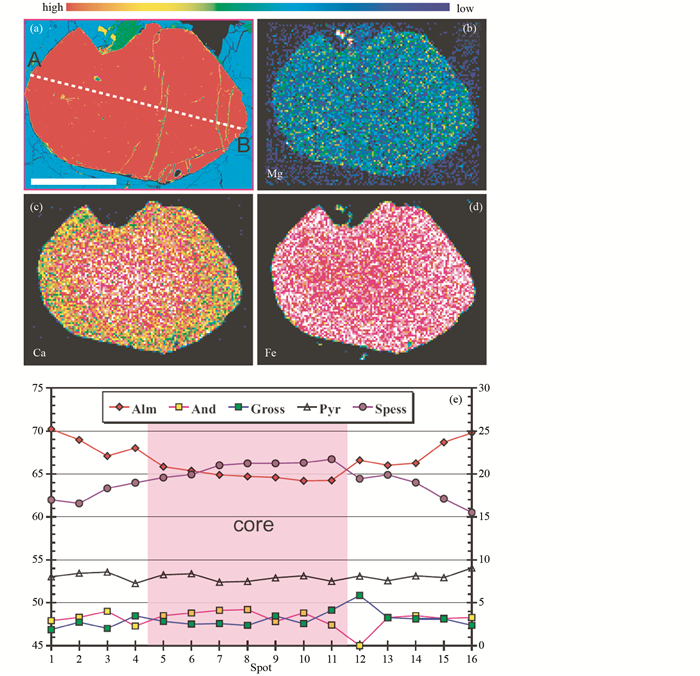
|
图 9 雅拉香波穹窿中新世淡色花岗岩中石榴子石矿物化学变化特征 (a)显微照片;Mg (b)、Mn (c)和Fe (d)元素X光成分图;(e)端元组分剖面变化图 Fig. 9 Mineral chemistry of magmatic garnets in the leucogranite from the Yardoi Gneiss Dome (a) micrograph; X-ray map of Mg (b), Mn (c) and Fe (d); (e) cross-section profile of end-member variations of garnet |
2件样品中的石榴子石都富集HREE,亏损LREE(图 10),但淡色花岗岩的石榴子石更富集HREE,(Yb/Gd)N比值为7.56~35.53,总体上大于二云母花岗岩的石榴子石((Yb/Gd)N=0.64~13.34),同时显示更显著的负Eu异常,淡色花岗岩和二云母花岗岩的石榴子石的Eu/Eu*比值分别为 < 0.03和0.09~0.23。在微量元素地球化学特征上,淡色花岗岩的Sc (80.4×10-6~137.2×10-6)、Y (2310×10-6×10-6~4079×10-6)和Zn (280×10-6~327×10-6)明显高于二云母花岗(Sc=25.0×10-6~37.2×10-6, Y=541×10-6~2539×10-6和Zn =102.9×10-6~142.9×10-6)(表 4)。
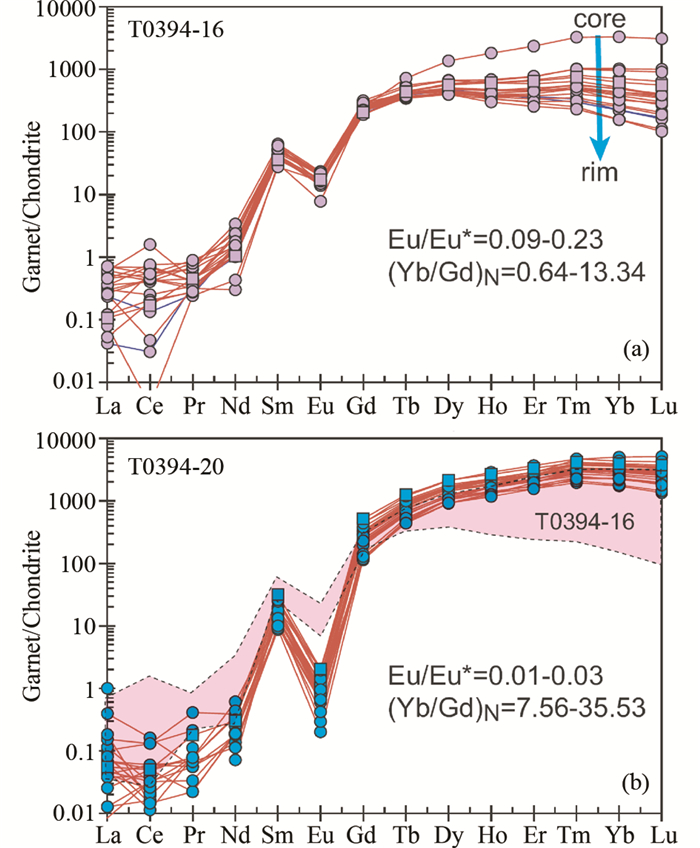
|
图 10 雅拉香波穹窿中新世岩浆型石榴子石稀土元素配分特征 Fig. 10 REE distribution patterns for magmatic garnets from two-mica granite (a) and leuogranite (b) from the Yardoi Gneiss Dome |
上述数据表明:(1)在高Sr/Y比二云母花岗岩和淡色花岗岩中,石榴子石的主要端元组分为铁铝榴石和锰铝榴石,锰铝榴石的组分较高(Xspess>13mol%), 与多数喜马拉雅淡色花岗岩和华南Sn-W成矿花岗岩相似(高利娥等, 2012;Yang et al., 2013; 郭春丽等,2017);(2)这些石榴子石富含Sc、Zn、Y和HREE。
3.3.2 石榴角闪岩的石榴子石(T0388/T0394-10/T394-1/ T0394-AM)为限定高Sr/Y比二云母花岗岩中石榴子石的成因,选择了4件石榴角闪岩样品,测试了石榴子石和共生角闪石的微量元素地球化学组成。
除个别点的HREE含量较低,(Yb/Gd)N比值小于1.0外,多数石榴子石都表现出富集HREE,亏损LREE(图 11),(Yb/Gd)N比值较高,高达54.5。同时多数石榴子石显示弱或无Eu异常。在T0394-01、T0388、T0394-10和T0394-Am中,(Yb/Gd)N比值分别为1.38~54.50、3.10~30.22、0.63~18.24和1.60~4.04(表 4),Eu/Eu*比值分别为0.17~1.08、0.57~0.94、0.84~1.29和0.39~1.20(表 4)。
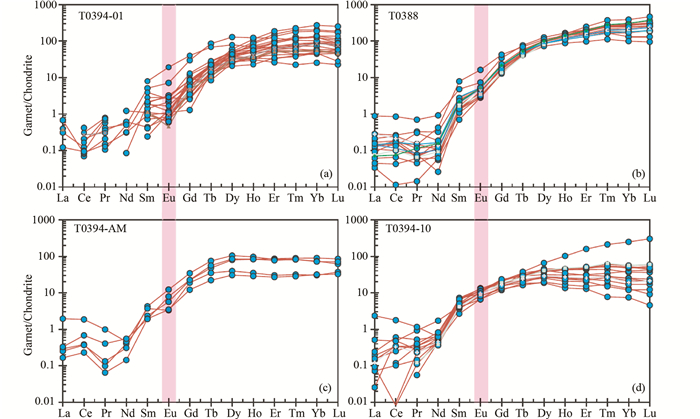
|
图 11 雅拉香波穹窿石榴角闪岩中石榴子石稀土元素配分特征 Fig. 11 REE distribution patterns for garnets from garnet amphibolite from the Yardoi Gneiss Dome |
与花岗岩中的石榴子石相比,石榴角闪岩的Sc(< 69.4×10-6)、Zn(< 95.2×10-6)和Y(< 242.2×10-6)含量都较低。如在样品T0394-01中,Sc、Y和Zn的含量分别为12.3×10-6~34.3×10-6、38.8×10-6~199.5×10-6和66.0×10-6~95.2×10-6。其它3件样品表现相似特征(图 12)。在石榴角闪岩中,与石榴子石共生的角闪石Sc(11.9×10-6~109.0×10-6)和Zn(316.3×10-6~618.6×10-6)较高(表 5),角闪石Zn的含量是石榴子石的5~10倍,是Zn的主要赋存矿物。因此,在石榴角闪岩部分熔融过程中,角闪石脱水部分熔融将分解角闪石,释放Zn,导致熔体的Zn升高。与Zn不同,Sc和Y在石榴子石中是相容元素,如果源岩存在早期变质石榴子石或角闪石脱水部分熔融形成转熔型石榴子石,那么原始熔体的Sc和Y都降低,与高Sr/Y比花岗岩相似。
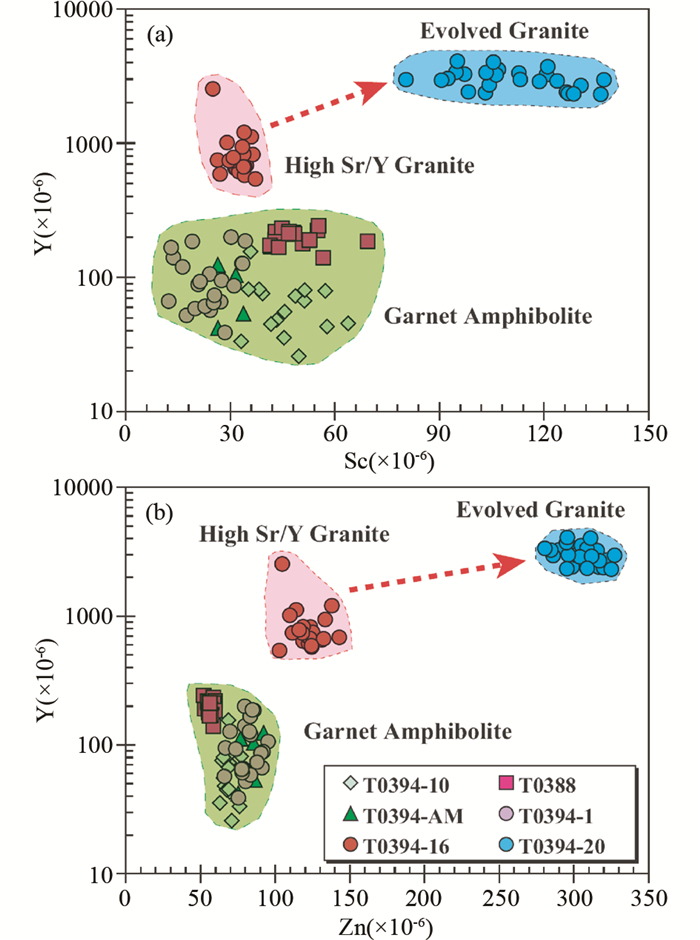
|
图 12 石榴子石的微量元素相关关系图 (a) Sc-Y; (b) Zn-Y Fig. 12 Co-variation diagrams showing the relationship between Sc and Y (a) and between Zn and Y (b) |
喜马拉雅造山带中新世淡色花岗岩具有:(1)高Rb、低Sr以及较高的Rb/Sr比(>1.0);(2)高初始Sr(87Sr/86Sr(t)>0.7300)和低初始Nd(εNd(t) < -12)同位素组成(Vidal et al., 1982; Debon et al., 1986; Deniel et al., 1987; Ferrara et al., 1991; Inger and Harris, 1993; Searle et al., 1997; 杨晓松和金振民, 2001; Zhang et al., 2004; King et al., 2011; Gao et al., 2017; Huang et al., 2017; 高利娥等,2017a)等特征,源区为变泥质岩(Gao and Zeng, 2014; 吴福元等, 2015;Gao et al., 2017; 曾令森和高利娥, 2017)。与多数喜马拉雅中新世淡色花岗岩相比,雅拉香波中新世二云母花岗岩具有高Sr/Y(86.5~216.6)和La/Yb(18.0~37.8)比值和富钠,较低Sr同位素(87Sr/86Sr(t)=0.7091~0.7098)和较高的Nd同位素(εNd(t)=-7.7~-8.5)组成等特征,预示着这些花岗岩的源区与同时代的淡色花岗岩不同。在雅拉香波穹窿-错那麻玛沟地区,较富沃变泥质岩的Sr同位素组成较高,87Sr/86Sr>0.7400, Nd同位素组成较低,εNd(t) < -12.0(高利娥等, 2009, 2010;曾令森等, 2009; Zeng et al., 2011a)。花岗质片麻岩的原岩年龄包括新元古代和早古生代(Gao et al., 2012; Wang et al., 2017), 具有较高Sr同位素组成(87Sr/86Sr>0.7600),但较低的Nd同位素组成(εNd(t)=-11.3~-16.6),和变泥质岩相似(Zeng et al., 2009, 2011a, 2015;和待发表数据)。上述可能的源岩与雅拉香波中新世二云母花岗岩的Sr-Nd同位素系统特征差异较大,不太可能是雅拉香波中新世二云母花岗岩的源区。
变泥质岩在高压(≥10kbar)条件下的水致部分熔融(H2O-fluxed melting)(Patino Douce and Harris, 1998; Zeng et al., 2012)或基性岩部分熔融(Conrad et al., 1988; Wolf and Wyllie, 1991, 1993, 1994; Rapp and Watson, 1995; Lopez et al. 2001; Zeng et al. 2009, 2011a)都可以产生富钠花岗岩。高压条件下,变泥质岩的水致部分熔融反应为:
(1) quartz+plagioclase+H2O→melt
(2) quartz+plagioclase+muscovite+H2O→melt+biotite
上述两个部分熔融反应都在饱水和低温(≤750℃)条件下进行。在部分熔融反应(1)中,白云母不参与熔融反应;在反应(2)中,黑云母呈残留相出现。在Patiño Douce and Harris(1998)的深熔反应实验中,在高压条件下,变泥质岩饱和水部分熔融产生的熔体显示富Na特征,在An-Ab-Or图上都落入奥长花岗岩区(Patiño Douce and Harris, 1998)。同时,在这些部分熔融反应中,独居石(低Sm/Nd比值和低εNd(t))的溶解作用占主导地位(Zeng et al., 2005),这些反应形成的熔体的Sr和Nd同位素比值与原岩相比,应显著降低,即87Sr/86Sr < 0.7400, εNd(t) < -12.0,这和雅拉香波中新世淡色花岗岩的Sr-Nd同位素系统特征不一致。因此,变泥质岩的水致部分熔融不太可能是形成雅拉香波中新世高Sr/Y比花岗岩的机制。
角闪岩在高压条件下的部分熔融是形成富钠和高Sr/Y比花岗岩的主要机制(Wolf and Wyllie, 1993; Rapp and Watson, 1995; López and Castro, 2001; 曾令森等, 2009; Zeng et al., 2011a)。角闪岩可能是中新世二云母花岗岩的源区。与变泥质岩和花岗质片麻岩相比,石榴角闪岩的Sr同位素比值较低,(87Sr/86Sr(t)=0.7115~0.7148),但Nd同位素比值较高但变化较大,εNd(t)=+1.4~-7.9(Zeng et al., 2011a)。雅拉香波中新世二云母花岗岩的Sr同位素组成稍低于石榴角闪岩,但Nd同位素组成相似。因此,在Sr同位素组成上,在形成高Sr/Y比花岗岩中,需要较亏损物质的加入。
虽然总体上淡色花岗岩与二云母花岗的Sr和Nd同位素相似,但淡色花岗岩的Sr同位素(87Sr/86Sr(t)= 0.7100~0.7103)稍高,但Nd同位素(εNd(t)=-9.1~-9.2)组成稍低(表 3),表明在二云母花岗岩演化到淡色花岗岩的过程中,经历了微弱的较富集组分的混染。在花岗质岩浆形成和演化过程中,选择性同化混染作用是导致同期共生花岗岩之间在素和同位素地球化学组成上表现出差异性的关键作用之一(Stevens et al., 2007; Taylor and Stevens, 2010; Zeng et al., 2012; 焦淑娟等,2013; Rong et al., 2017, 2018)。在选择性同化混染作用中,来自变质围岩的转熔型石榴子石和其它易熔组分可通过溶解-再结晶作用融入到花岗质岩浆中(Taylor and Stevens, 2010; Rong et al., 2017, 2018),导致演化程度较高的花岗岩具有较低的SiO2和Nd同位素组成,但较高的Sr同位素组成。
4.2 石榴子石矿物化学成分变化的原因与石榴角闪岩石榴子石相比,花岗岩石榴子石在主量元素和微量元素地球化学特征上都表现出较大的差异(表 4), 在石榴子石的铁铝榴石和锰铝榴石组分上,在Sc-Y-Zn的含量上都明显不同。花岗岩中的石榴子石不可能是捕获源区的石榴子石。在Sc-Y-Zn关系上,与二云母花岗岩中的石榴子石相比,淡色花岗岩的Sc、Y和Zn的含量(图 12)及其Eu负异常幅度明显较高(图 10)。当与周围矿物组合平衡时,影响石榴子石的微量元素地球化学特征的因素有:(1)残留岩浆的有效总体成分;和(2)石榴子石与基质矿物之间的元素总体配分系数(Chernoff and Carlson, 1999; Carlson, 2002)。在岩浆演化过程中,岩浆补充、来自围岩的同化混染作用、矿物分离结晶作用等都可能导致岩浆成分的变化,尤其是在某些区域,局部岩浆可能事先达到锰铝榴石-铁铝榴石的饱和溶解度,结晶石榴子石,导致不同时期形成的石榴子石微量元素成分的变化。但上述花岗岩的熔体成分变化较小,对石榴子石的元素配分行为影响较小,石榴子石微量元素组成的变化更可能反映了石榴子石结晶熔体成分的变化。
在花岗质岩浆结晶分异过程中,石英、斜长石和钾长石都是贫Mn、Sc、Zn、Y和HREE的矿物(Heinrichs et al., 1980; Tuisku et al., 1987), 在残留熔体中,这些元素的含量随结晶作用程度的增高而升高。石榴子石结晶常常晚于石英、斜长石和钾长石,从残留熔体中结晶的石榴子石的Sc、Y、Zn和HREE较高。同时,在花岗质岩浆演化过程中,富Ca斜长石具有较高程度的Eu正异常(Weill and Drake, 1973),富Ca斜长石的分离结晶作用不仅导致局部熔体的Si和Na升高,而且导致熔体的LREE总量升高和Eu负异常幅度的增大(Zeng et al., 2011a)。斜长石的结晶作用摄取了大量的Eu元素,导致其他共生矿物的高度负Eu异常,这是导致花岗岩中岩浆型石榴子石具有高度Eu负异常的主要因素。因此,从岩浆中结晶形成的石榴子石含有较高的锰铝榴石组分,富集HREE,明显Eu负异常等特征。同时,由于瑞利分馏作用的影响,从岩浆型石榴子石的核部到边部,HREE逐渐降低(高利娥等, 2012)。
另一种可能是,如果石榴子石和长英质矿物同时结晶,Sc、Y、Zn和HREE在石英和长石中都是不相容元素,倾向于优先配分到石榴子石中,也导致这些元素在石榴子石中的含量较高。如在花岗岩中,重稀土元素在主要造岩矿物中都是不相容元素,在岩浆结晶演化中,倾向于进入熔体,促使岩浆型石榴子石富集重稀土元素。
5 结论雅拉香波片麻岩穹隆发育年龄分别为20.3±0.5Ma和20.1±0.3Ma的含石榴子石高Sr/Y比二云母花岗岩(TMG)和淡色花岗岩(Grt-LG)。淡色花岗岩和二云母花岗岩分别代表演化程度较高和较原始的岩浆。在两类花岗岩中,岩浆型石榴子石在生长环带和REE变化特征上具有相似性,但在Eu负异常和关键微量元素(Zn、Sc和Y)上,都表现出明显的差异性。上述观测表明:高Sr/Y花岗岩也可以结晶石榴子石,与通常的淡色花岗岩石榴子石相比,这些石榴子石的Sc、Zn和Y含量和Eu异常幅度明显较低。但随分异程度的升高,石榴子石的元素地球化学特征与源自变沉积岩的淡色花岗岩的类似。因此,花岗岩中的石榴子石矿物化学特征变化记录了花岗岩岩浆演化的重要信息。
致谢 感谢赵志丹教授、戚学祥研究员和本刊编辑对本文提出了宝贵的修改意见。
Abbott Jr RN. 1981. The role of manganese in the paragenesis of magmatic garnet:An example from the Old Woman-Piute Range, California:A discussion. The Journal of Geology, 89(6): 767-769 |
Aikman AB, Harrison TM and Ding L. 2008. Evidence for Early (>44Ma) Himalayan crustal thickening, Tethyan Himalaya, southeastern Tibet. Earth and Planetary Science Letters, 274(1-2): 14-23 DOI:10.1016/j.epsl.2008.06.038 |
Allan BD and Clarke DB. 1981. Occurrence and origin of garnets in the South Mountain Batholith, Nova Scotia. Canadian Mineralogist, 19: 19-24 |
Aoya M, Wallis SR, Terada K, Lee J, Kawakami T, Wang Y and Heizler M. 2005. North-south extension in the Tibetan crust triggered by granite emplacement. Geology, 33(11): 853-856 DOI:10.1130/G21806.1 |
Burg JP, Guiraud M, Chen GM and Li GC. 1984. Himalayan metamorphism and deformations in the North Himalayan Belt (southern Tibet, China). Earth and Planetary Science Letters, 69(2): 391-400 |
Carlson WD. 2002. Scales of disequilibrium and rates of equilibration during metamorphism. American Mineralogist, 87(2-3): 185-204 DOI:10.2138/am-2002-2-301 |
Cawood PA, Johnson MRW and Nemchin AA. 2007. Early Palaeozoic orogenesis along the Indian margin of Gondwana:Tectonic response to Gondwana assembly. Earth and Planetary Science Letters, 255(1-2): 70-84 DOI:10.1016/j.epsl.2006.12.006 |
Cawthorn RG and Brown PA. 1976. A model for the formation and crystallization of corundum-normative calc-alkaline magmas through amphibole fractionation. The Journal of Geology, 84(4): 467-476 DOI:10.1086/628212 |
Chernoff CB and Carlson WD. 1999. Trace element zoning as a record of chemical disequilibrium during garnet growth. Geology, 27(6): 555-558 DOI:10.1130/0091-7613(1999)027<0555:TEZAAR>2.3.CO;2 |
Clarke DB. 2007. Assimilation of xenocrysts in granitic magmas:Principles, processes, proxies, and problems. Canadian Mineralogist, 45(1): 5-30 |
Conrad WK, Nicholls IA and Wall VJ. 1988. Water-saturated and undersaturated melting of metaluminous and peraluminous crustal compositions at 10kb:Evidence for the origin of silicic magmas in the Taupo volcanic zone, New Zealand, and other occurrences. Journal of Petrology, 29(4): 765-803 DOI:10.1093/petrology/29.4.765 |
Dahlquist JA, Galindo C, Pankhurst RJ, Rapela CW, Alasino PH, Saavedra J and Fanning CM. 2007. Magmatic evolution of the Peñón Rosado granite:Petrogenesis of garnet-bearing granitoids. Lithos, 95(3-4): 177-207 DOI:10.1016/j.lithos.2006.07.010 |
Debon F, Le Fort P, Sheppard SMF and Sonet J. 1986. The four plutonic belts of the Transhimalaya-Himalaya:A chemical, mineralogical, isotopic, and chronological synthesis along a Tibet-Nepal Section. Journal of Petrology, 27(1): 219-250 DOI:10.1093/petrology/27.1.219 |
Deniel C, Vidal P, Fernandez A, Le Fort P and Peucat JJ. 1987. Isotopic study of the Manaslu granite (Himalaya, Nepal):Inferences on the age and source of Himalayan leucogranites. Contributions to Mineralogy and Petrology, 96(1): 78-92 DOI:10.1007/BF00375529 |
DiPietro JA and Isachsen CE. 2001. U-Pb zircon ages from the Indian plate in northwest Pakistan and their significance to Himalayan and pre-Himalayan geologic history. Tectonics, 20(4): 510-525 DOI:10.1029/2000TC001193 |
Du Bray EA. 1988. Garnet compositions and their use as indicators of peraluminous granitoid petrogenesis-southeastern Arabian Shield. Contributions to Mineralogy and Petrology, 100(2): 205-212 DOI:10.1007/BF00373586 |
Ferrara G, Lombardo B, Tonarini S and Turi B. 1991. Sr, Nd and O isotopic characterization of the Gophu La and Gumburanjun leucogranites (High Himalaya). Schweizerische Mineralogische und Petrographische Mitteilungen, 71: 35-51 |
Gao LE, Zeng LS, Liu J and Xie KJ. 2009. Early Oligocene Na-rich peraluminous leucogranites in the Yardoi gneiss dome, southern Tibet:Formation mechanism and tectonic implications. Acta Petrologica Sinica, 25(9): 2289-2302 (in Chinese with English abstract) |
Gao LE, Zeng LS and Hu GY. 2010. High Sr/Y two-mica granite from Quedang area, southern Tibet:Formation mechanism and tectonic implications. Geological Bulletin of China, 29(2-3): 214-226 (in Chinese with English abstract) |
Gao LE, Zeng LS and Xie KJ. 2012. Eocene high grade metamorphism and crustal anatexis in the North Himalaya Gneiss Domes, Southern Tibet. Chinese Science Bulletin, 57(6): 639-650 DOI:10.1007/s11434-011-4805-4 |
Gao LE, Zeng LS, Shi WG, Chen ZY, Hu MY and Sun DY. 2012. Two types of garnets in the Cenozoic granites from the Himalayan Orogenic Belt:Geochemical characteristics and implications for crustal anatexis. Acta Petrologica Sinica, 28(9): 2963-2980 (in Chinese with English abstract) |
Gao LE, Zeng LS, Hou KJ, Guo CL, Tang SH, Xie KJ, Hu GY and Wang L. 2013. Episodic crustal anatexis and the formation of Paiku composite leucogranitic pluton in the Malashan Gneiss Dome, Southern Tibet. Chinese Science Bulletin, 58(28-29): 3546-3563 DOI:10.1007/s11434-013-5792-4 |
Gao LE and Zeng LS. 2014. Fluxed melting of metapelite and the formation of Miocene high-CaO two-mica granites in the Malashan gneiss dome, southern Tibet. Geochimica et Cosmochimica Acta, 130: 136-155 DOI:10.1016/j.gca.2014.01.003 |
Gao LE, Zeng LS, Xu ZQ and Wang L. 2015. Himalaya in the Caledonia Time:A Record from the Malashan-Gyirong area, southern Tibet. Acta Petrologica Sinica, 31(5): 1200-1218 (in Chinese with English abstract) |
Gao LE, Zeng LS and Asimow PD. 2017. Contrasting geochemical signatures of fluid-absent versus fluid-fluxed melting of muscovite in metasedimentary sources:The Himalayan leucogranites. Geology, 45(1): 39-42 DOI:10.1130/G38336.1 |
Gao LE, Gao JH, Zhao LH, Hou KJ and Tang SH. 2017a. The Miocene leucogranite in the Nariyongcuo Gneiss Domes, southern Tibet:Products from melting metapelite and fractional crystallization. Acta Petrologica Sinica, 33(8): 2395-2411 (in Chinese with English abstract) |
Gao LE, Zeng LS, Zhao LH, Hu MY, Wang L, Gao JH and Shang Z. 2017b. Multiphase growth of garnet in gneisses from the Himalayan orogenic belt. Acta Petrologica Sinica, 33(12): 3729-3740 (in Chinese with English abstract) |
Gao LE, Zeng LS, Hu GY, Wang YY, Wang Q, Guo CL and Hou KJ. 2019. Early Paleozoic magmatism along the northern margin of East Gondwana. Lithos, 334-335: 25-41 DOI:10.1016/j.lithos.2019.03.007 |
Gao LS, Zeng LS, Gao JH, Shang Z, Hou KJ and Wang Q. 2016. Oligocene crustal anatexis in the Tethyan Himalaya, southern Tibet. Lithos, 264: 201-209 DOI:10.1016/j.lithos.2016.08.038 |
Gehrels GE, Decelles PG, Ojha TP and Upreti BN. 2006. Geologic and U-Th-Pb geochronologic evidence for Early Paleozoic tectonism in the Kathmandu thrust sheet, central Nepal Himalaya. GSA Bulletin, 118(1-2): 185-198 DOI:10.1130/B25753.1 |
Green TH. 1976. Experimental generation of cordierite-or garnet-bearing granitic liquids from a pelitic composition. Geology, 4(2): 85-88 |
Green TH. 1977. Garnet in silicic liquids and its possible use as a P-T indicator. Contributions to Mineralogy and Petrology, 65(1): 59-67 DOI:10.1007/BF00373571 |
Groppo C, Lombardo B, Rolfo F and Pertusati P. 2007. Clockwise exhumation path of granulitized eclogites from the Ama Drime range (Eastern Himalayas). Journal of Metamorphic Geology, 25(1): 51-75 DOI:10.1111/jmg.2007.25.issue-1 |
Guo CL, Zeng LS, Gao LE, Su HZ, Ma XH and Yin B. 2017. Highly fractionated grantitic minerals and whole-rock geochemistry prospecting markers in Hetian, Fujian Province. Acta Geologica Sinica, 91(8): 1796-1817 (in Chinese with English abstract) |
Hall A and Tyler RC. 1965. The origin of accessory garnet in the Donegal granite. Mineralogical Magazine, 35(272): 628-633 DOI:10.1180/minmag.1965.035.272.06 |
Harrison TM, Grove M, Lovera OM, Catlos EJ and D'Andrea J. 1999. The origin of Himalayan anatexis and inverted metamorphism:Models and constraints. Journal of Asian Earth Sciences, 17(5-6): 755-772 DOI:10.1016/S1367-9120(99)00018-8 |
Heinrichs H, Schulz-Dobrick B and Wedepohl KH. 1980. Terrestrial geochemistry of Cd, Bi, Tl, Pb, Zn and Rb. Geochimica et Cosmochimica Acta, 44(10): 1519-1533 DOI:10.1016/0016-7037(80)90116-7 |
Hodges KV. 2000. Tectonics of the Himalaya and southern Tibet from two perspectives. GSA Bulletin, 112(3): 324-350 DOI:10.1130/0016-7606(2000)112<324:TOTHAS>2.0.CO;2 |
Hou ZQ, Zheng YC, Zeng LS, Gao LE, Huang KX, Li W, Li QY, Fu Q, Liang W and Sun QZ. 2012. Eocene-Oligocene granitoids in southern Tibet:Constraints on crustal anatexis and tectonic evolution of the Himalayan orogen. Earth and Planetary Science Letters, 349-350: 38-52 DOI:10.1016/j.epsl.2012.06.030 |
Hu GY, Zeng LS, Gao LE, Liu QP, Chen H and Guo YS. 2018. Diverse magma sources for the Himalayan leucogranites:Evidence from B-Sr-Nd isotopes. Lithos, 314-315: 88-99 DOI:10.1016/j.lithos.2018.05.022 |
Hu MY, He HL, Zhan XC, Fan XT, Wang G and Jia ZR. 2008. Matrix normalization for in-situ multi-element quantitative analysis of zircon in laser ablation-inductively coupled plasma mass spectrometry. Chinese Journal of Analytical Chemistry, 36(7): 947-953 (in Chinese with English abstract) |
Huang CM, Zhao ZD, Li GM, Zhu DC, Liu D and Shi QS. 2017. Leucogranites in Lhozag, southern Tibet:Implications for the tectonic evolution of the eastern Himalaya. Lithos, 294-295: 246-262 DOI:10.1016/j.lithos.2017.09.014 |
Inger S and Harris N. 1993. Geochemical constraints on leucogranite magmatism in the Langtang valley, Nepal Himalaya. Journal of Petrology, 34(2): 345-368 DOI:10.1093/petrology/34.2.345 |
Jiao SJ, Guo JH and Peng SB. 2013. Petrogenesis of garnet in the Darongshan-Shiwandashan granitic suite of the South China Block and the metamorphism of the granulite enclave. Acta Petrologica Sinica, 29(5): 1740-1758 (in Chinese with English abstract) |
Jiao SJ, Li XH, Huang HQ and Deng XG. 2015. Metasedimentary melting in the formation of charnockite:Petrological and zircon U-Pb-Hf-O isotope evidence from the Darongshan S-type granitic complex in southern China. Lithos, 239: 217-233 DOI:10.1016/j.lithos.2015.10.004 |
King J, Harris N, Argles T, Parrish R and Zhang HF. 2011. Contribution of crustal anatexis to the tectonic evolution of Indian crust beneath southern Tibet. GSA Bulletin, 123(1-2): 218-239 DOI:10.1130/B30085.1 |
Le Fort P, Cuney M, Deniel C, France-Lanord C, Sheppard SMF, Upreti BN and Vidal P. 1987. Crustal generation of the Himalayan leucogranites. Tectonophysics, 134(1-3): 39-57 DOI:10.1016/0040-1951(87)90248-4 |
Le Breton N and Thompson AB. 1988. Fluid-absent (dehydration) melting of biotite in metapelites in the early stages of crustal anatexis. Contributions to Mineralogy and Petrology, 99(2): 226-237 DOI:10.1007/BF00371463 |
Lee J, Hacker B and Wang Y. 2004. Evolution of North Himalayan gneiss domes:Structural and metamorphic studies in Mabja Dome, southern Tibet. Journal of Structural Geology, 26(12): 2297-2316 DOI:10.1016/j.jsg.2004.02.013 |
Lee J and Whitehouse MJ. 2007. Onset of mid-crustal extensional flow in southern Tibet:Evidence from U/Pb zircon ages. Geology, 35(1): 45-48 DOI:10.1130/G22842A.1 |
Liu YS, Gao S, Hu ZC, Gao CG, Zong KQ and Wang DB. 2010. Continental and oceanic crust recycling-induced melt-peridotite interactions in the Trans-North China Orogen:U-Pb dating, Hf isotopes and trace elements in zircons from mantle xenoliths. Journal of Petrology, 51(1-2): 537-571 DOI:10.1093/petrology/egp082 |
Liu ZC, Wu FY, Ji WQ, Wang JG and Liu CZ. 2014. Petrogenesis of the Ramba leucogranite in the Tethyan Himalaya and constraints on the channel flow model. Lithos, 208-209: 118-136 DOI:10.1016/j.lithos.2014.08.022 |
Liu ZC, Wu FY, Ding L, Liu XC, Wang JG and Ji WQ. 2016. Highly fractionated Late Eocene (~35Ma) leucogranite in the Xiaru Dome, Tethyan Himalaya, South Tibet. Lithos, 240-243: 337-354 DOI:10.1016/j.lithos.2015.11.026 |
López S and Castro A. 2001. Determination of the fluid-absent solidus and supersolidus phase relationships of MORB-derived amphibolites in the range 4~14kbar. American Mineralogist, 86(11-12): 1396-1403 DOI:10.2138/am-2001-11-1208 |
Miller C, Thöni M, Frank W, Grasemann B, Klötzli U, Guntli P and Draganits E. 2001. The Early Palaeozoic magmatic event in the Northwest Himalaya, India:Source, tectonic setting and age of emplacement. Geological Magazine, 138(3): 237-251 DOI:10.1017/S0016756801005283 |
Miller CF and Stoddard EF. 1981. The role of manganese in the paragenesis of magmatic garnet:An example from the Old Woman-Piute Range, California. The Journal of Geology, 89(2): 233-246 |
Murphy MA. 2007. Isotopic characteristics of the Gurla Mandhata metamorphic core complex:Implications for the architecture of the Himalayan orogen. Geology, 35(11): 983-986 DOI:10.1130/G23774A.1 |
Patiño Douce AE and Harris N. 1998. Experimental constraints on Himalayan Anatexis. Journal of Petrology, 39(4): 689-710 DOI:10.1093/petroj/39.4.689 |
Qi XX, Zeng LS, Meng XJ, Xu ZQ and Li TF. 2008. Zircon SHRIMP U-Pb dating for Dala granite in the Tethyan Himalaya and its geological implication. Acta Petrologica Sinica, 24(7): 1501-1508 (in Chinese with English abstract) |
Quigley MC, Yu LJ, Gregory C, Corvino A, Sandiford M, Wilson CJL and Liu XH. 2008. U-Pb SHRIMP zircon geochronology and T-t-d history of the Kampa Dome, southern Tibet. Tectonophysics, 446(1-4): 97-113 DOI:10.1016/j.tecto.2007.11.004 |
Rapp RP, Watson EB and Miller CF. 1991. Partial melting of amphibolite/eclogite and the origin of Archean trondhjemites and tonalites. Precambrian Research, 51(1): 1-25 |
Rapp RP and Watson EB. 1995. Dehydration melting of metabasalt at 8~32kbar:Implications for continental growth and crust-mantle recycling. Journal of Petrology, 36(4): 891-931 DOI:10.1093/petrology/36.4.891 |
Richards A, Parrish R, Harris N, Argles T and Zhang L. 2006. Correlation of lithotectonic units across the eastern Himalaya, Bhutan. Geology, 34(5): 341-344 DOI:10.1130/G22169.1 |
Rong W, Zhang SB and Zheng YF. 2017. Back-reaction of peritectic garnet as an explanation for the origin of mafic enclaves in S-type granite from the Jiuling batholith in South China. Journal of Petrology, 58(3): 569-598 DOI:10.1093/petrology/egx029 |
Rong W, Zhang SB, Zheng YF and Gao P. 2018. Mixing of felsic magmas in granite petrogenesis:Geochemical records of zircon and garnet in peraluminous granitoids from South China. Journal of Geophysical Research:Solid Earth, 123(4): 2738-2769 DOI:10.1002/jgrb.v123.4 |
Searle MP, Parrish RR, Hodges KV, Hurford A, Ayres MW and Whitehouse MJ. 1997. Shisha Pangma leucogranite, South Tibetan Himalaya:Field relations, geochemistry, age, origin, and emplacement. Journal of Geology, 105(3): 295-318 DOI:10.1086/515924 |
Spear FS and Kohn MJ. 1996. Trace element zoning in garnet as a monitor of crustal melting. Geology, 24(12): 1099-1102 DOI:10.1130/0091-7613(1996)024<1099:TEZIGA>2.3.CO;2 |
Stevens G, Villaros A and Moyen JF. 2007. Selective peritectic garnet entrainment as the origin of geochemical diversity in S-type granites. Geology, 35(1): 9-12 DOI:10.1130/G22959A.1 |
Sun SS and McDonough WF. 1989. Chemical and isotopic systematics of oceanic basalts:Implications for mantle composition and processes. In:Saunders AD and Norry MJ (eds.). Magmatism in the Ocean Basins. Geological Society, London, Special Publications, 42(1): 313-345 DOI:10.1144/GSL.SP.1989.042.01.19 |
Taylor J and Stevens G. 2010. Selective entrainment of peritectic garnet into S-type granitic magmas:Evidence from Archaean mid-crustal anatectites. Lithos, 120(3-4): 277-292 DOI:10.1016/j.lithos.2010.08.015 |
Tuisku P, Ruosresuo P and Häkkinen AM. 1987. The metamorphic behaviour and petrogenetic significance of zinc in amphibolite facies, staurolite-bearing mica schists, Puolankajärvi Formation, central Finland. Geochimica et Cosmochimica Acta, 51(6): 1639-1650 DOI:10.1016/0016-7037(87)90344-9 |
Vidal P, Cocherie A and Le Fort P. 1982. Geochemical investigations of the origin of the Manaslu leucogranite (Himalaya, Nepal). Geochimica et Cosmochimica Acta, 46(11): 2279-2292 DOI:10.1016/0016-7037(82)90201-0 |
Villaros A, Stevens G, Moyen JF and Buick IS. 2009. The trace element compositions of S-type granites:Evidence for disequilibrium melting and accessory phase entrainment in the source. Contributions to Mineralogy and Petrology, 158(4): 543-561 DOI:10.1007/s00410-009-0396-3 |
Wang JM, Rubatto D and Zhang JJ. 2015. Timing of partial melting and cooling across the greater Himalayan crystalline complex (Nyalam, Central Himalaya):In-sequence thrusting and its implications. Journal of Petrology, 56(9): 1677-1702 DOI:10.1093/petrology/egv050 |
Wang YH, Zeng LS, Gao LE, Zhang LF and Hou KJ. 2014. Labradonian and Greenvillian orogenic events in the Namche Barwa Massif of the Himalayan orogenic belt. Acta Petrologica Sinica, 30(8): 2241-2252 (in Chinese with English abstract) |
Wang YH, Zeng LS, Gao LE, Guo CL, Hou KJ, Zhang LF, Wang W and Sun HY. 2017. Neoproterozoic magmatism in eastern Himalayan Terrane. Science Bulletin, 62(6): 415-424 DOI:10.1016/j.scib.2017.02.003 |
Warren RC. 1970. Electron microprobe investigations of almandine garnets from a quartz diorite stock and adjacent metamorphic rocks, British Columbia. Eos, Transactions, American Geophysical Union, 51: 444 |
Weill DF and Drake MJ. 1973. Europium anomaly in plagioclase feldspar:Experimental results and semiquantitative model. Science, 180(4090): 1059-1060 DOI:10.1126/science.180.4090.1059 |
Wolf MB and Wyllie PJ. 1991. Dehydration-melting of solid amphibolite at 10kbar:Textural development, liquid interconnectivity and applications to the segregation of magmas. Mineralogy and Petrology, 44(3-4): 151-179 DOI:10.1007/BF01166961 |
Wolf MB and Wyllie PJ. 1993. Garnet growth during amphibolite anatexis:Implications of a garnetiferous restite. Journal of Geology, 101(3): 357-373 DOI:10.1086/648229 |
Wolf MB and Wyllie PJ. 1994. Dehydration-melting of amphibolite at 10kbar:The effects of temperature and time. Contributions to Mineralogy and Petrology, 115(4): 369-383 DOI:10.1007/BF00320972 |
Wu FY, Liu ZC, Liu XC and Ji WQ. 2015. Himalayan leucogranite:Petrogenesis and implications to orogenesis and plateau uplift. Acta Petrologica Sinica, 31(1): 1-36 (in Chinese with English abstract) |
Wyllie PJ and Wolf MB. 1993. Amphibolite dehydration-melting:Sorting out the solidus. In:Prichard HM, Alabaster T and Harris NBW (eds.). Magmatic Processes and Plate Tectonics. Geological Society, London, Special Publication, 76:405-416 https://authors.library.caltech.edu/64955/
|
Xia QX, Zhou LG and Zheng YF. 2013. Zonation and multiphase growth of garnet in UHP metamorphic rocks of continental subduciton zone. Chinese Science Bulletin, 58(22): 2138-2144 (in Chinese) |
Xie KJ, Zeng LS, Liu J and Gao LE. 2010. Late-Eocene Dala adakitic granite, southern Tibet and geological implications. Acta Petrologica Sinica, 26(4): 1016-1026 (in Chinese with English abstract) |
Yang JH, Peng TT, Hu RZ, Bi XW, Zhao JH, Fu YZ and Shen NP. 2013. Garnet geochemistry of tungsten-mineralized Xihuashan granites in South China. Lithos, 177: 79-90 DOI:10.1016/j.lithos.2013.06.008 |
Yang XS and Jin ZM. 2001. Studies on Rb-Sr and Sm-Nd isotope of Yadong leucogranite in Tibet:Constraint on its age and source material. Geological Review, 47(3): 294-300 (in Chinese with English abstract) |
Yu JJ, Zeng LS, Liu J, Gao LE and Xie KJ. 2011. Early Miocene leucogranites in Dinggye area, southern Tibet:Formation mechanism and tectonic implications. Acta Petrologica Sinica, 27(7): 1961-1972 (in Chinese with English abstract) |
Zeng LS, Asimow PD and Saleeby JB. 2005. Coupling of anatectic reactions and dissolution of accessory phases and the Sr and Nd isotope systematics of anatectic melts from a metasedimentary source. Geochimica et Cosmochimica Acta, 69(14): 3671-3682 DOI:10.1016/j.gca.2005.02.035 |
Zeng LS, Liang FH, Xu ZQ and Qi XX. 2008. Metapelites in the Himalayan orogenic belt and their protoliths. Acta Petrologica Sinica, 24(7): 1517-1527 (in Chinese with English abstract) |
Zeng LS, Liu J, Gao LE, Xie KJ and Wen L. 2009. Early Oligocene anatexis in the Yardoi gneiss dome, southern Tibet and geological implications. Chinese Science Bulletin, 54(1): 104-112 DOI:10.1007/s11434-008-0362-x |
Zeng LS, Gao LE, Xie KJ and Liu-Zeng J. 2011a. Mid-Eocene high Sr/Y granites in the Northern Himalayan Gneiss Domes:Melting thickened lower continental crust. Earth and Planetary Science Letters, 303(3-4): 251-266 DOI:10.1016/j.epsl.2011.01.005 |
Zeng LS, Gao LE and Xie KJ. 2011b. Concurrence of Mid-Miocene high Sr/Y granite and leucogranite in the Yardoi gneiss dome, Tethyan Himalaya, Southern Tibet. Mineralogical Magazine, 75(3): 2245 |
Zeng LS, Gao LE, Dong CY and Tang SH. 2012. High-pressure melting of metapelite and the formation of Ca-rich granitic melts in the Namche Barwa Massif, Southern Tibet. Gondwana Research, 21(1): 138-151 DOI:10.1016/j.gr.2011.07.023 |
Zeng LS, Chen J, Gao LE and Chen ZY. 2012. The geochemical nature of apatites in high Sr/Y two-mica granites from the North Himalayan Gneiss Domes, southern Tibet. Acta Petrologica Sinica, 28(9): 2981-2993 (in Chinese with English abstract) |
Zeng LS, Gao LE, Tang SH, Hou KJ, Guo CL and Hu GY. 2015. Eocene magmatism in the Tethyan Himalaya, southern Tibet. In:Mukherjee S, Carosi R, van der Beek PA, Mukherjee BK and Robinson DM (eds.). Tectonics of the Himalaya. Geological Society, London, Special Publications, 412: 287-316 |
Zeng LS and Gao LE. 2017. Cenozoic crustal anatexis and the leucogranites in the Himalayan collisional orogenic belt. Acta Petrologica Sinica, 33(5): 1420-1444 (in Chinese with English abstract) |
Zhang HF, Harris N, Parrish R, Kelley S, Zhang L, Rogers N, Argles T and King J. 2004. Causes and consequences of protracted melting of the mid-crust exposed in the North Himalayan antiform. Earth and Planetary Science Letters, 228(1-2): 195-212 DOI:10.1016/j.epsl.2004.09.031 |
Zhang JJ, Guo L and Zhang B. 2007. Structure and kinematics of the Yalashangbo dome in the northern Himalayan dome belt, China. Chinese Journal of Geology, 42(1): 16-30 (in Chinese with English abstract) |
Zhang JJ, Santosh M, Wang XX, Guo L, Yang XY and Zhang B. 2012. Tectonics of the northern Himalaya since the India-Asia collision. Gondwana Research, 21(4): 939-960 DOI:10.1016/j.gr.2011.11.004 |
Zhang ZM, Wang JL, Zhao GC and Shi C. 2008. Geochronology and Precambrian tectonic evolution of the Namche Barwa complex from the eastern Himalayan syntaxis, Tibet. Acta Petrologica Sinica, 24(7): 1477-1487 (in Chinese with English abstract) |
Zhao K, Xu XS, Erdmann S, Liu L and Xia Y. 2017. Rapid migration of a magma source from mid-to deep-crustal levels:Insights from restitic granulite enclaves and anatectic granite. GSA Bulletin, 129(11-12): 1708-1725 |
Zhao L, Guo F, Fan WM, Li CW, Qin XF and Li HX. 2012. Origin of the granulite enclaves in Indo-sinian peraluminous granites, South China and its implication for crustal anatexis. Lithos, 150: 209-226 DOI:10.1016/j.lithos.2012.02.015 |
高利娥, 曾令森, 刘静, 谢克家. 2009. 藏南也拉香波早渐新世富钠过铝质淡色花岗岩的成因机制及其构造动力学意义. 岩石学报, 25(9): 2289-2302. |
高利娥, 曾令森, 胡古月. 2010. 藏南确当地区高Sr/Y比值二云母花岗岩的形成机制及其构造动力学意义. 地质通报, 29(2-3): 214-226. |
高利娥, 曾令森, 石卫刚, 陈振宇, 胡明月, 孙东阳. 2012. 喜马拉雅造山带新生代花岗岩中两类石榴石的地球化学特征及其在地壳深熔作用中的意义. 岩石学报, 28(9): 2963-2980. |
高利娥, 曾令森, 许志琴, 王莉. 2015. 喜马拉雅造山带加里东期构造作用:以马拉山-吉隆构造带为例. 岩石学报, 31(5): 1200-1218. |
高利娥, 高家昊, 赵令浩, 侯可军, 唐索寒. 2017a. 藏南拿日雍错片麻岩穹窿中新世淡色花岗岩的形成过程:变泥质岩部分熔融与分离结晶作用. 岩石学报, 33(8): 2395-2411. |
高利娥, 曾令森, 赵令浩, 胡明月, 王莉, 高家昊, 尚振. 2017b. 喜马拉雅造山带片麻岩中石榴子石的多期生长. 岩石学报, 33(12): 3729-3740. |
郭春丽, 曾令森, 高利娥, 苏红中, 马星华, 尹冰. 2017. 福建河田高分异花岗岩的矿物和全岩地球化学找矿标志研究. 地质学报, 91(8): 1796-1817. DOI:10.3969/j.issn.0001-5717.2017.08.010 |
胡明月, 何红蓼, 詹秀春, 樊兴涛, 王广, 贾泽荣. 2008. 基体归一定量技术在激光烧蚀-等离子体质谱法锆石原位多元素分析中的应用. 分析化学, 36(7): 947-953. DOI:10.3321/j.issn:0253-3820.2008.07.016 |
焦淑娟, 郭敬辉, 彭松柏. 2013. 华南大容山-十万大山花岗岩体中石榴石成因以及麻粒岩包体变质作用研究. 岩石学报, 29(5): 1740-1758. |
戚学祥, 曾令森, 孟祥金, 许志琴, 李天福. 2008. 特提斯喜马拉雅打拉花岗岩的锆石SHRIMP U-Pb定年及其地质意义. 岩石学报, 27(7): 1501-1508. |
王誉桦, 曾令森, 高利娥, 张立飞, 侯可军. 2014. 喜马拉雅造山带东构造结拉布拉多期和格林威尔期造山作用的记录. 岩石学报, 30(8): 2241-2252. |
吴福元, 刘志超, 刘小驰, 纪伟强. 2015. 喜马拉雅淡色花岗岩. 岩石学报, 31(1): 1-36. |
夏琼霞, 周李岗, 郑永飞. 2013. 大陆俯冲带超高压变质岩石中石榴石的环带和多阶段生长. 科学通报, 58(22): 2138-2144. |
谢克家, 曾令森, 刘静, 高利娥. 2010. 西藏南部晚始新世打拉埃达克质花岗岩及其构造动力学意义. 岩石学报, 26(4): 1016-1026. |
杨晓松, 金振民. 2001. 西藏亚东淡色花岗岩Rb-Sr和Sm-Nd同位素研究——关于其年龄和源岩的证据. 地质论评, 47(3): 294-300. DOI:10.3321/j.issn:0371-5736.2001.03.012 |
于俊杰, 曾令森, 刘静, 高利娥, 谢克家. 2011. 藏南定结地区早中新世淡色花岗岩的形成机制及其构造动力学意义. 岩石学报, 27(7): 1961-1972. |
曾令森, 梁凤华, 许志琴, 戚学祥. 2008. 喜马拉雅造山带变泥质岩系及其地球化学特征. 岩石学报, 24(7): 1517-1527. |
曾令森, 刘静, 高利娥, 谢克家, 文力. 2009. 藏南也拉香波穹隆早渐新世地壳深熔作用及其地质意义. 科学通报, 54(3): 373-381. |
曾令森, 陈晶, 高利娥, 陈振宇. 2012. 藏南北喜马拉雅穹窿高Sr/Y二云母花岗岩中磷灰石地球化学特征及其岩石学意义. 岩石学报, 28(9): 2981-2993. |
曾令森, 高利娥. 2017. 喜马拉雅碰撞造山带新生代地壳深熔作用与淡色花岗岩. 岩石学报, 33(5): 1420-1444. |
张进江, 郭磊, 张波. 2007. 北喜马拉雅穹隆带雅拉香波穹隆的构造组成和运动学特征. 地质科学, 42(1): 16-30. DOI:10.3321/j.issn:0563-5020.2007.01.003 |
张泽明, 王金丽, 赵国春, 石超. 2008. 喜马拉雅造山带东构造结南迦巴瓦岩群地质年代学和前寒武纪构造演化. 岩石学报, 24(7): 1477-1487. |
 2019, Vol. 35
2019, Vol. 35













